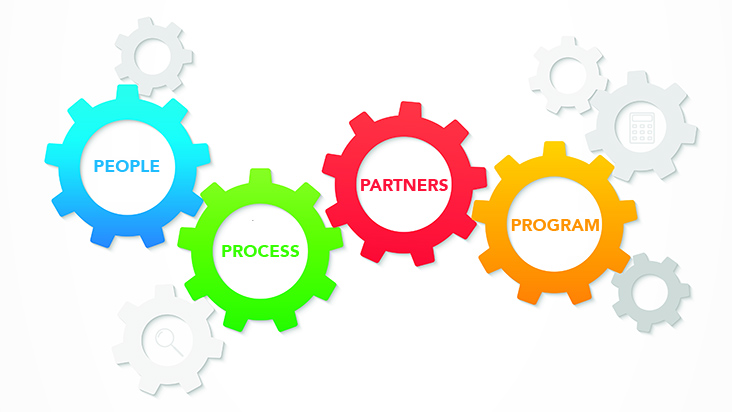The 4Ps to Partner Process Automation Readiness
When you’re getting your proverbial ducks in a row to automate your partner process there are four key areas that you must have in place before you begin to implement, or even choose, a Partner Relationship Management (PRM) solution or other automation. The below 4 P’s are the building blocks to any successful program and should be reviewed even when you’re adding new automated functionality to an existing program, such as MDF or Lead Distribution.
People
One of the biggest challenges any organization has is finding and cultivating the right team to move their strategies forward, and the channel is no different.
- Ensure your team has the right mix of skills.
- The number of channel professionals on your team will vary widely depending on the size of your program—we work with successful programs that even have one or two on their team—but at the end of the day you will need someone thinking about all elements whether they are doing all the work or not.
- Important roles include partner marketing, partner operations, partner experience, partner communication, and partner programs.
- Train your team on the fundamentals of channel and partner business models.
- Define who will manage the new automation elements.
- Ensure the team has the bandwidth and the understanding of the system and process.

Process
A well-defined process is a key element to every partner automation project, but it is very hard to automate a process that doesn’t exist. How do your current processes translate, or change, when you implement automation? Take this as an opportunity to re-evaluate your current processes and how they will best work in this new framework.
Develop an end to end process for each element the automation will touch and identify the resources needed to support it. This can include:
- Deal Registration flow
- Who internally is going to update/maintain your content
- How are you going to integrate your CRM such as Salesforce or HubSpot so you can minimize redundant tasks and ensure you don’t duplicate information?
- When partners call or email requesting content that is available via automation, how will your team reinforce the use of the automation to increase adoption rates?
- How does your MDF process change once automated?
Understanding the process will help you align with your automation platform quicker and allow you to gain ROI faster.
Partners
When determining your readiness for partner automation you must identify how the automation aligns with your partner’s needs. There are a lot of great automation modules available, but not all are applicable to every program. You must have partners that can actually use what you are about to implement and receive direct benefits that align with the automation.
Also be mindful of the time it takes for partners to adopt your new automation, such as deal registration or even having partners go to the portal rather than email you. As we mention in the other ‘Ps’, creating a clear message around the benefits to the partners is a critical part of preparing to implement automation and having partners start using the tools your offer.
Program
When adding in partner process automation elements it is key to make sure that there is a defined value proposition for your channel program. Any new automation should have a clear set of benefits to the partner, and be tied back to your programmatical elements. Doing this will enable partners to easily identify the benefits of your automation offering to their organization.
Your new automation should align with and drive forward your program objectives. Also, no matter how much planning you do prior to going live with a PRM solution or other automation, you will want to iterate the processes based on feedback from your partners, your team, and the overall benefits they are bringing to the program.
The only way to iterate effectively is to ensure there is a clear way to measure the success and effectiveness of the tool, and as with other elements of your program, it’s all about your willingness and openness to change as your measure those results. Usage and performance are also important gauges for success.
With these four elements inline you will not only be prepared to find a platform that best matches your current and future needs, but will also be able to configure and roll it out to your partners to set you up for the best chance of success. With the right People, Partners, Process and Program your automation project will have the recipe for success.
Effective Partner Training Brings Big Rewards
5 Strategies to Elevate Your Partner Program in the New Year